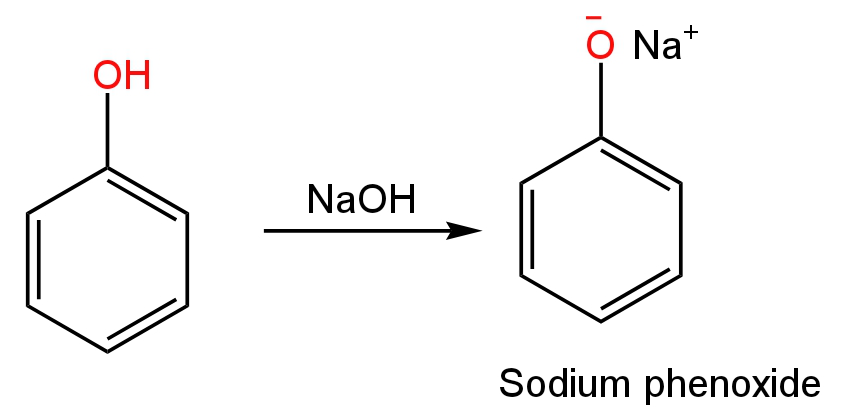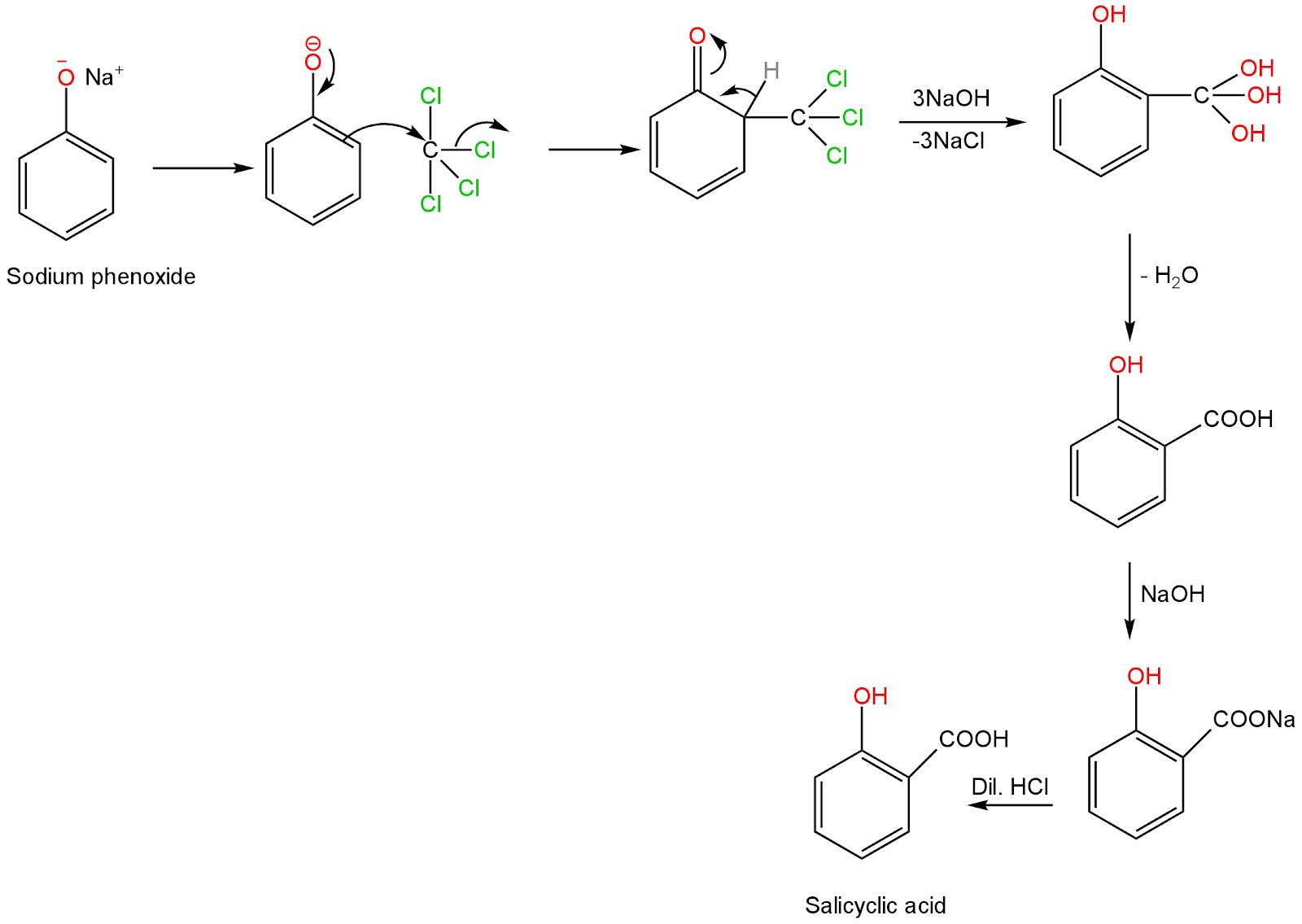
Salicylic acid is prepared from phenol by:
A. Reimer-Tiemann reaction
B. Kolbe's reaction
C. Kolbe-electrolysis reaction
D. None of the above
Answer
225k+ views
Hint: Reaction of phenol with carbon tetrachloride in aqueous sodium hydroxide gives salicylic acid as the major product.
It is called the Reimer-Tiemann reaction.
Complete step-by-step answer:
In the reaction of phenol with carbon tetrachloride in aqueous sodium or potassium hydroxide, salicylic acid is the product.
This reaction occurs at 340 K temperature.
The IUPAC name of Salicylic acid is 2-hydroxybenzoic acid.
The mechanism of the reaction is as follows:
It is an electrophilic substitution reaction.
The first step involves the removal of the proton from phenol in aqueous sodium hydroxide giving sodium phenoxide as the product.

Image: Sodium phenoxide ion formation
The next step involves the attack of carbon tetrachloride at the ortho position of the benzene ring.
This leads to the replacement of three chlorine atoms with three hydroxide ions.
The removal of a molecule of water happens in the following step.
The product when reacted with aqueous sodium hydroxide followed by dilute hydrochloric acid forms 2-Hydroxybenzoic acid or salicylic acid.

Image: Formation of salicylic acid from sodium phenoxide ion.
So, option A is correct.
Additional Information: Reaction of phenol with chloroform in aqueous sodium or potassium hydroxide at temperature 340 K then hydrolysis of the resulting product forms 2-hydroxybenzaldehyde or salicylaldehyde as the primary product.
Note: Reimer-Tiemann reaction is the production of salicylic acid and salicylaldehyde using phenol as the reactant.
For the formation of salicylic acid, carbon tetrachloride is used as a reagent and for salicylaldehyde, chloroform is used as a reagent.
It is called the Reimer-Tiemann reaction.
Complete step-by-step answer:
In the reaction of phenol with carbon tetrachloride in aqueous sodium or potassium hydroxide, salicylic acid is the product.
This reaction occurs at 340 K temperature.
The IUPAC name of Salicylic acid is 2-hydroxybenzoic acid.
The mechanism of the reaction is as follows:
It is an electrophilic substitution reaction.
The first step involves the removal of the proton from phenol in aqueous sodium hydroxide giving sodium phenoxide as the product.

Image: Sodium phenoxide ion formation
The next step involves the attack of carbon tetrachloride at the ortho position of the benzene ring.
This leads to the replacement of three chlorine atoms with three hydroxide ions.
The removal of a molecule of water happens in the following step.
The product when reacted with aqueous sodium hydroxide followed by dilute hydrochloric acid forms 2-Hydroxybenzoic acid or salicylic acid.

Image: Formation of salicylic acid from sodium phenoxide ion.
So, option A is correct.
Additional Information: Reaction of phenol with chloroform in aqueous sodium or potassium hydroxide at temperature 340 K then hydrolysis of the resulting product forms 2-hydroxybenzaldehyde or salicylaldehyde as the primary product.
Note: Reimer-Tiemann reaction is the production of salicylic acid and salicylaldehyde using phenol as the reactant.
For the formation of salicylic acid, carbon tetrachloride is used as a reagent and for salicylaldehyde, chloroform is used as a reagent.
Recently Updated Pages
JEE Main 2025-26 Mock Test: Organic Compounds Containing Nitrogen

JEE Main 2025-26 Organic Compounds Containing Nitrogen Mock Test

JEE Main Chemical Kinetics Mock Test 2025-26: Free Practice Online

JEE Main 2025-26 Organic Compounds Containing Oxygen Mock Test

JEE Main 2025-26 Organic Compounds Containing Halogens Mock Test

Sodium acetate on heating with soda lime produce A class 12 chemistry JEE_Main

Trending doubts
Understanding Atomic Structure for Beginners

Understanding Electromagnetic Waves and Their Importance

Understanding Average and RMS Value in Electrical Circuits

Half Life of Zero Order Reaction for JEE

Understanding Displacement and Velocity Time Graphs

Understanding How a Current Loop Acts as a Magnetic Dipole

Other Pages
JEE Advanced 2026 - Exam Date (Released), Syllabus, Registration, Eligibility, Preparation, and More

JEE Advanced 2026 - Exam Date (Released), Syllabus, Registration, Eligibility, Preparation, and More

JEE Advanced Weightage 2025 Chapter-Wise for Physics, Maths and Chemistry

NCERT Solutions For Class 12 Chemistry Chapter 2 Chapter 2 Solutions Hindi Medium in Hindi - 2025-26

Aldehyde Ketone and Carboxylic Acid Class 12 Chemistry Chapter 8 CBSE Notes - 2025-26

Which of the following will not undergo H V Z reaction class 12 chemistry JEE_Main




